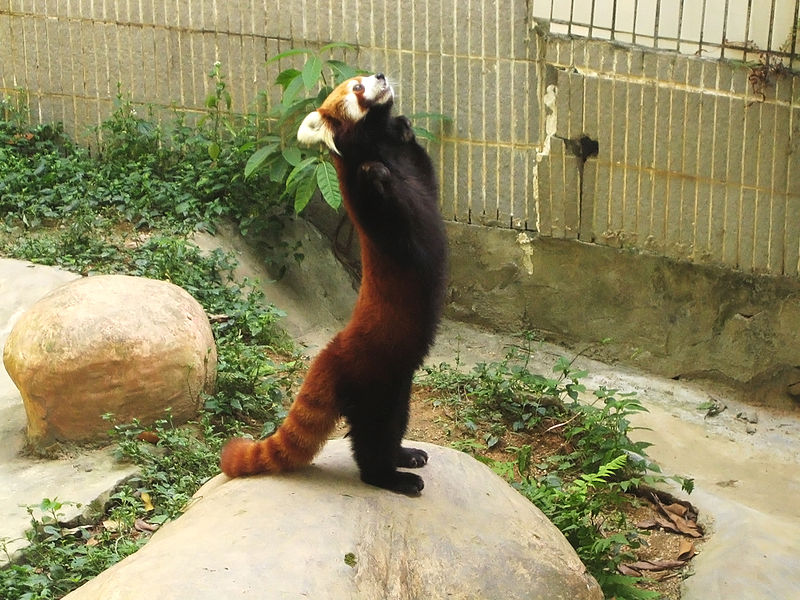.
Ailurus fulgens (Red Pandas, or Fire Cats), Ocean Park, Hong Kong: photo by Tango Chen, 2009
Every time the bucks went clattering
Over Oklahoma
A firecat bristled in the way.
Wherever they went,
They went clattering,
Until they swerved
In a swift, circular line
To the right,
Because of the firecat.
Or until they swerved
In a swift, circular line
To the left,
Because of the firecat.
The bucks clattered.
The firecat went leaping,
To the right, to the left,
And
Bristled in the way.
Later, the firecat closed his bright eyes
And slept.
Wallace Stevens: Earthy Anecdote, 1918, from Harmonium, 1923

Ailurus fulgens (Red Pandas, or Fire Cats), Chengdu Giant Panda Breeding Research Base: photo by Colegota, 2006

Ailurus fulgens (Red Panda, or Fire Cat), descending head first down a tree, Cincinnati Zoo: photo by Greg5030. 2010

Ailurus fulgens (Red Panda, or Fire Cat), standing: photo by Daniel Wong, 2005

Ailurus fulgens (Red Panda, or Fire Cat) cubs, wrestling: photo by Jonathan L. Kang, 2006

Ailurus fulgens (Red Panda, or Fire Cat), Rosamund Gifford Zoo, Syracuse, New York: photo by Dave Pape, 2007

Ailurus fulgens (Red Panda, or Fire Cat), staying cool under the mister, Akron Zoo: photo by redpandasrule, 2007

Ailurus fulgens (Red Panda, or Fire Cat), Woodland Park Zoo, Seattle: photo by saska01, 2007

Ailurus fulgens (Red Panda, or Fire Cat), sleeping in a tree: photo by Thomas Binderhofer, 2002

I was looking for something exactly like this this morning and now I've found it, so thank you for this. One question (since I waded through a few pretty tedious analyses of the Stevens poem and the question wasn't addressed in any of them), do you know whether Stevens was aware of this beautiful Asian creature or did he use the word "firecat" poetically, i.e., suggestively? I'm still considering yesterday's Kafka/Adorno post, which provides plenty to think about.
ReplyDeleteCurtis,
ReplyDeleteWell, just to get the critical ball & chain rolling... here are some Firecats (Red Pandas) playing at the Chengdu Panda Research Station -- which is the site of the second photo in the post, the one directly beneath the Stevens poem.
The academic criticism of this poem, like the academic criticism of every Stevens poem, coats my already dull brain with a redundant glaze.
It "must be some sort of manifesto," declares Helen Vendler with the tempting lure of an oracle, "but of what was it the proclamation?"
(Now that's what I'd call letting the side down in the clutch, Helen.)
I've discovered an article by an academic from Antwerp (yet), cautioning against "eco-readings" of this poem.
That drives me into the arms of an eco-reading...
And yes, I too, here in the dark, broken leg and all, have spent much of the night asking myself repeatedly, "Did Stevens know what a firecat is/was?"
In favor of a "Yes" answer: the "bristling", and the "bright eyes". (The Latin taxonomic moniker of this creature means "shining cat".)
On the other hand, upon arising, the mistress of the manor has suggested, with characteristic sensibleness, that Stevens may have been thinking about wild fires moving across the prairie, and thus using "firecat" metaphorically.
Holly Stevens, in a memoir, quotes this letter from her father, and suggests this lightning storm might have happened on the way across Oklahoma:
"Thence I went through Nebraska and Iowa (which is a superb state) and on to Niagara Falls and to New York and home. The best thing I saw was a lightning storm on the prairie. I leaned out of the smoking-room window and watched the incessant forks darting down to the horizon. Now and then great clouds would flare and the ground would flash with yellow shadows."
But Oklahoma would be a bit out of the way, if one were leaving Nebraska, headed East.
And then there is an 1895 letter to mother, in which young Wally quotes a humorous drinking song evidently then current:
"Oh! hic - keep to the middle of the road/Oh! hic - keep to the middle of the road/Don't look to the right/Don't look to the left/But keep to the middle of the road."
Oh, well, boys will be boys (hic).
But... he said stubbornly... the poem actually makes more sense to me and gives me more pleasure of mind and spirit if I read it in the belief that the poet DOES know what he is talking about, the real animal, and is not simply uttering meaningless phantasmagoric "modernist" (or "post"-etc.) gibberish.
So: you heard it here first: Earthy Anecdote is absolutely about that beautiful and elusive endangered creature, native to the Himalayas, Ailuris fulgens.
That's the conclusion I reached also, using a process very similar to yours. I encountered the "eco-reading" reference also and was again reminded that sometimes you run into words that usefully say to you, "stay away -- you have better things to do". I hope your leg is healing and not giving you too much pain. Every day, I am slightly less stiff from my shoveling accident, but every time I twist myself badly the recovery period lengthens. We have new storms on the way, which will be inconvenient. "Redundant glaze" -- I like that.
ReplyDeleteRon Padgett, an authentic Oklahoma native, adds this useful observation:
ReplyDelete"Until today I had never seen a picture of a firecat. What a beautiful animal. But, as you know, not native to Oklahoma. I guess Stevens liked to put things in states he didn't go to (the jar in Tennessee, for example) and see what happened. This poem is a semi-pantoum for children. And, like the jar poem, it has an undercurrent of hilarity."
Tom,
ReplyDeleteLook at that firecat (Red Panda) asleep in a tree (Johnny will love this when he gets back), wonder if he's related to that red-tailed hawk who's screeching out here. . . .
1.11
grey whiteness of clouds above shadowed
plane of ridge, red-tailed hawk calling
in foreground, sound of wave in channel
thought that look, wait and
hear what after paint
point in this case, has not
thought, half of what
silver of sunlight reflected in channel,
white cloud in pale blue sky on horizon
Tom,
ReplyDeleteYes, I like Ron's note about it being "a semi-pantoum for children," and linking it to the jar in Tennesee, and your insistence that WS knew what firecats are. And I am hoping your leg is on the quick road to complete recovery. . . .
well
ReplyDeletesince your broken leg was mentioned
I guess this
http://content.healthaffairs.org/content/30/1/173.full
fits in..
this guy I forgot to note his name, apologies to him:
is now age 56 an x-professor now about 6 years
everything else from me is
needless to say!
Well, now I know what a pantoum is, and have figured out what a semi-pantoum would be also. This afternoon, we saw the fox who spends time around our house, which is always really special. It reminded me of the firecat. Caroline just said that she thinks he's a Roberts now, which was nice to hear. Some other things aside, it was a pretty productive day.
ReplyDeleteTom,
ReplyDeleteOr maybe it was that "lightning storm on the prairie" -- reimagined as a cat. (I was driving across the Nevada desert a few years ago, saw lone telephone pole beside road burning (struck by the lighting that was now off above the ridge to the north -- what a vision). Off soon to Denver, we'll see. . . .
1.12
grey blackness of sky against invisible
ridge, black shapes of leaves on branch
in foreground, sound of wave in channel
wind starts again, branch
scratching the window
thinking relation between,
sides, look, approach
grey-white clouds to the left of point,
shadowed green pine on tip of sandspit
Thanks, Ed. Actually there's a bit of pain in the lower quadrant of the pantoum this morning, but I'm advised not to share the thrilling details.
ReplyDeleteCurtis, you perhaps knew that the Chinese call Ailuris fulgens "fire fox"?
(And here's the odd thing: a flaming-orange fire fox is embracing the earth at this moment. On my bottom icon rack, that is.)
Steve,
I admire and envy your mobility (especially as I currently have none).
Here's hoping Denver proves propitious, as we're sure it will, for you.
In fact, whatever it is you've been doing -- nearly getting hit by lightning & c. - seems to be working brilliantly, if the adept manipulation of consonants and vowels in poetry is to be taken as an indicator.
In recent months we've viewed a number of Academy Award screeners in which all the young American male actors (well, all American male actors are young) suffer an inability to enunciate that reduces them to a steady monotone muttering mumble. With this in mind, I'd propose a newfangled acting academy should be founded upon the initiatory test of saying this final couplet aloud 1,000 times:
grey-white clouds to the left of point,
shadowed green pine on tip of sandspit
speaking of actors acting...
ReplyDeletejust happened to turn on The Idiot Box
to find playing
Sir Laurence Olivier (et al) 's HAMLET
I think that this is a restored film as
every frame is crisp/sharp &
EVERY WORD ...strikes-home.
twould Olivier had made the ENTIRE play..
MAN
to hear the rhythms & diction of the actors DOING Shakespeare no matter WHO wrote "Shakespeare"
"is there not rain enough to wash away (etc)..."
(and the play on the 3 or four meanings of "rain"..
The enigma of poetry is integral to its power - as in this Stevens poem. There is an interesting article in the new London Review of Books concerning the origin of the boar in more than one of Paul Celan's poems, which sort of runs parallel to the speculation here. The article isn't available in full online, however, there is a discussion of Celan's boar in the review of a new novel by Lawrence Norfolk.
ReplyDeleteAll of this is interwoven with an accusation by Yvan Goll and his widow of plagiarism as Celan translated a volume of Goll's work. However, the boar clearly appears in an earlier poem by Celan, as well as later poems. His reluctance to defend himself only obliquely adds even another layer of mystery. In the LRB article, Celan himself wonders where the boar came from.
A mystery within a mystery.
(Didn't mean to get so far off thread, but the connections all came together and the parallel to the mystery of Stevens's firecat seems somehow at the core of meaning - the enigma of the image.)
Don
Yes, Don, the enigma wrapped in the mystery and the Chinese-boxes layering of everything we don't know in and/or about the poem... somehow adding to its ripples, its reverberations.
ReplyDeleteReminds us that the play's the thing, as Ed suggests --
"and the play on the 3 or four meanings of 'rain'..."